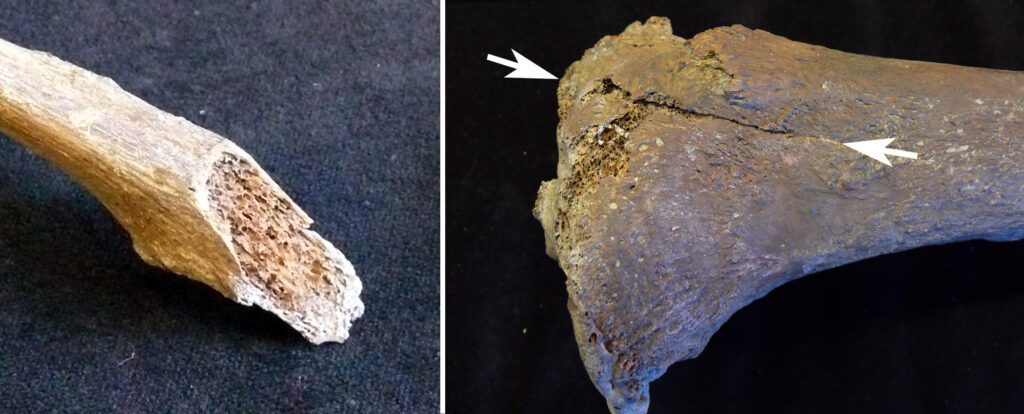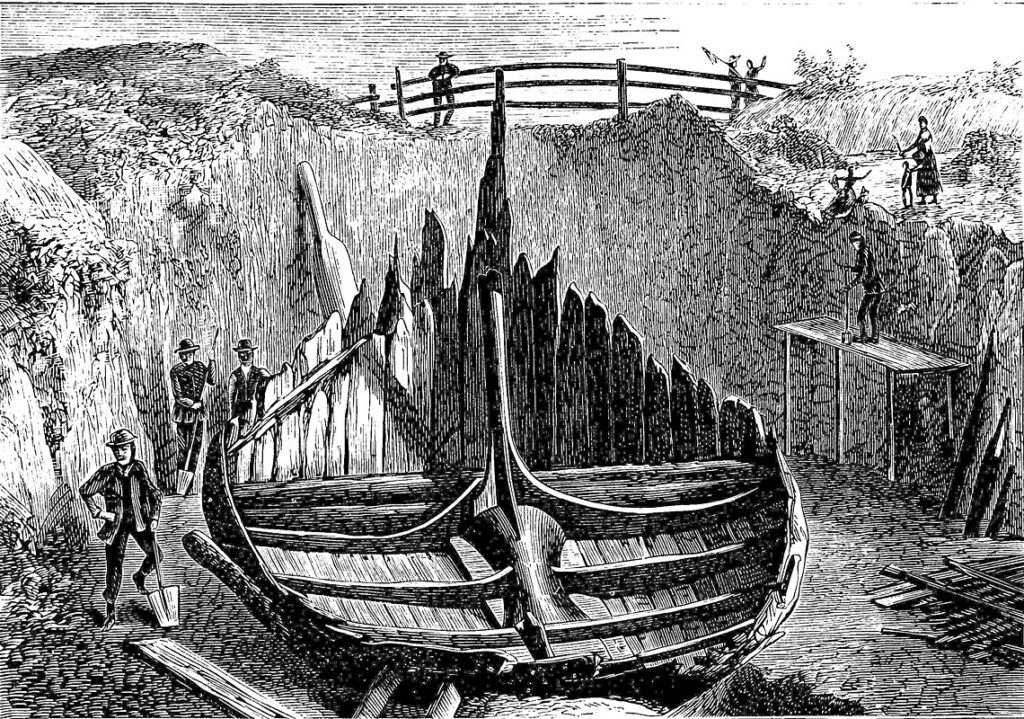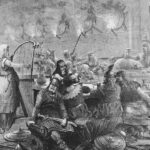Only eight pieces of human skeletal material were found in the famous ship burial at Gokstad. Despite this pittance of remains, those eight pieces tell a fascinating story about the individual from which they came. The Gokstad man was most likely a male in his 40s, standing roughly 182 cm tall (notably taller than average for his time), and extremely muscular—shoulder fragments, a humerus (upper arm bone), and both femora (upper leg bones) all show massive muscle attachment sites, making him not only taller but more powerfully-built. The base of the skull survives, and the flattened shape of the sella turcica (the location of the pituitary gland) suggests that he may have exhibited a condition called acromegaly.
Acromegaly is caused when the pituitary gland continues to secret growth hormones after the individual should normally have stopped growing. While a subadult person is maturing, the ends of the limb bones (the epiphyses) are not yet fused to their shafts, and it is in the space between the shaft and the epiphysis that new bone creation takes place. Once this space itself becomes fully fused, the bone cannot continue to grow, and growth hormone production generally ceases. But if the growth hormone production continues, certain other parts of the body can still be affected and result in extra growth: mainly the cartilage (the padding between bones) and the periosteum (a membrane which covers the outside of the bone). In the case of acromegaly, facial bones become enlarged and the mandible becomes elongated. People with this condition thus tend to have enlarged facial features, including cartilaginous areas like the ears and nose, but also the tongue. Other side effects include visual disturbances, headaches, and some muscular weakness.
In addition to this condition, the Gokstad man shows a variety of other pathologies. He suffered an injury to his left knee at some point in his life which, while not fatal, almost certainly left him with a limp. Whatever he took in the knee, it did not end his career as an adventurer—but one wonders if this injury may have hindered his later fight for survival. The Gokstad man was ultimately cut down in battle, as evidenced by the multitude of cut marks on the lower extremities. The lower end of the right fibula (one of the low leg bones) has been cut off by a slash coming from above. The inside of the right femur has a cut from a knife or an arrowhead which may have severed an artery. The inner side of the left tibia (the other low leg bone) has a 4 cm long cut at the knee, likely from a sword. This cut would have slashed the patellar tendon, making it impossible to stand upright on that leg. The placement of this cut is nearly impossible to reproduce on a standing person, suggesting he was either on a horse, or already on the ground when the blow landed. And these are just the cuts worth mentioning in detail. Microscopic analysis of these cuts determined that they happened while he was still alive. Evidence from the cuts also suggests at least two different weapons, from which we can assume there were at least two attackers.

Taking all of this information together, we can imagine this giant of a man striding into battle, sword or axe swinging. He is a massive man with a long reach. His opponents are shorter, meaning they cannot get close to his head, neck, or chest—the best targets for a lethal blow, as people tend to die very quickly with weapons lodged in their skulls or hearts. Instead, they go for the most viable target remaining: his legs. Where the Gokstad man has the reach to go high, his attackers have to go low. One of them manages to bring the man down, and as he lies on the ground injured, his enemies pounce. And so our hero dies.
Unfortunately, with only these eight bones, we cannot determine with certainty how he actually died. None of the surviving bones shows clearly lethal trauma, and so it remains a bit of a guess as to where the killing blow (or blows) landed. The cuts to his leg bones show no signs of healing, meaning they occurred nearly simultaneously with his death. The placement of some of these blows (especially the knee and tibia injuries) suggests that they were inflicted after he had already fallen—perhaps in an effort to ensure that he didn’t get up again.
It is a shame we lack the full skeleton. If we did, we might have been able to finish our little story, and perhaps even shed more light on who the man was. The grandeur of the grave indicates its occupant was a man of great renown, and when it was first excavated, some believed the Gokstad man to be one Olaf Geirsted-Alf—half-brother to the famous Halfdan the Black. However, more recent dating of the ship has made this identification uncertain.
As it stands now, though, what we can say is that whoever the Gokstad man was, he seems to have both lived and also gone to his grave in true Viking fashion.

Further reading:
Per Holck, 2009. “The skeleton from the Gokstad Ship: New evaluation of an old find.” Norwegian Archaeological Review, vol. 42, no. 1.
Ortner, D.J. 2003. “Identification of Pathological Conditions in Human Skeletal Remains, second edition”. Academic Press.
Cover photo: Per Holck (University of Oslo).
About the author
Cindy Levesque
Cindy G Levesque is a biological anthropologist and archaeologist from New Brunswick, Canada. She completed her Bachelor of Arts degree at the University of New Brunswick, and her Master of Science degree at Sheffield University in England. She currently lives in Uppsala, Sweden.


